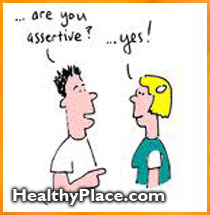Assertiveness, Non-Assertiveness, and Assertive Techniques
Many with depression don't stand up for themselves. Are you having difficulty with being assertive? Here's how to be more assertive, deal with aggressiveness and improve the communication process.
Table of Contents
- Introduction
- Non-Assertiveness
- Assertiveness
- Aggressiveness
- How To Improve the Communication Process
- Evaluate Your Assertions
- Assertive Techniques
- Method of Conflict Resolution
- Every person's Bill of Rights
Introduction
 Difficulty with being assertive has stereotypically been a challenge ascribed to women. However, research on violence and men's roles demonstrated that many physical altercations result from poor communication which then escalates into larger conflicts.
Difficulty with being assertive has stereotypically been a challenge ascribed to women. However, research on violence and men's roles demonstrated that many physical altercations result from poor communication which then escalates into larger conflicts.
Many men feel powerless in the face of aggressive communication from men or women in their lives; conversely, passivity in some situations can arouse frustration and anger for many men. As such, assertiveness can be an effective tool for men who are seeking to proactively alleviate violence in their lives, as well as a tool for fostering healthier, more satisfying lives.
Sociologists and mental health professionals are finding that assertiveness is usually displayed in certain circumstances. That is, assertiveness is not a personality trait which persists consistently across all situations. Different individuals exhibit varying degrees of assertive behavior depending on whether they are in a work, social, academic, recreational or relationship context. Therefore, a goal for assertiveness training is to maximize the number of context in which an individual is able to communicate assertively.
Non-Assertiveness
A non-assertive person is one who is often taken advantage of, feels helpless, takes on everyone's problems, says yes to inappropriate demands and thoughtless requests, and allows others to choose for him or her. The basic message he/she sends is "I'm not OK."
The non-assertive person is emotionally dishonest, indirect, self-denying, and inhibited. He/she feels hurt, anxious, and possibly angry about his/her actions.
Non-Assertive Body Language:
- Lack of eye contact; looking down or away.
- Swaying and shifting of weight from one foot to the other.
- Whining and hesitancy when speaking.
Assertiveness
An assertive person is one who acts in his/her own best interests, stands up for self, expresses feelings honestly, is in charge of self in interpersonal relations, and chooses for self. The basic message sent from an assertive person is "I'm OK and you're OK."
An assertive person is emotionally honest, direct, self-enhancing, and expressive. He/she feels confident, self-respecting at the time of his/her actions as well as later.
Assertive Body Language:
- Stand straight, steady, and directly face the people to whom you are speaking while maintaining eye contact.
- Speak in a clear, steady voice - loud enough for the people to whom you are speaking to hear you.
- Speak fluently, without hesitation, and with assurance and confidence.
Aggressiveness
An aggressive person is one who wins by using power, hurts others, is intimidating, controls the environment to suit his/her needs, and chooses for others. An aggressive says, "You're not OK."
He/she is inappropriately expressive, emotionally honest, direct, and self-enhancing at the expense of another. An aggressive person feels righteous, superior, deprecatory at the time of action and possibly guilty later.
Aggressive Body Language:
- Leaning forward with glaring eyes.
- Pointing a finger at the person to whom you are speaking.
- Shouting.
- Clenching the fists.
- Putting hands on hips and wagging the head.
Remember: ASSERTIVENESS IS NOT ONLY A MATTER OF WHAT YOU SAY, BUT ALSO A FUNCTION OF HOW YOU SAY IT!
How To Improve the Communication Process
- Active listening: reflecting back (paraphrasing) to the other person both words and feelings expressed by that person.
- Identifying your position: stating your thoughts and feelings about the situation.
- Exploring alternative solution: brainstorming other possibilities; rating the pros and cons; ranking the possible solutions.
Making Simple Requests:
- You have a right to make your wants known to others.
- You deny your own importance when you do not ask for what you want.
- The best way to get exactly what you want is to ask for it directly.
- Indirect ways of asking for what you want may not be understood.
- Your request is more likely to be understood when you use assertive body language.
- Asking for what you want is a skill that can be learned.
- Directly asking for what you want can become a habit with many pleasant rewards.
Refusing requests:
- You have a right to say NO!
- You deny your own importance when you say yes and you really mean no.
- Saying no does not imply that you reject another person; you are simply refusing a request.
- When saying no, it is important to be direct, concise, and to the point.
- If you really mean to say no, do not be swayed by pleading, begging, cajoling, compliments, or other forms of manipulation.
- You may offer reasons for your refusal, but don't get carried away with numerous excuses.
- A simple apology is adequate; excessive apologies can be offensive.
- Demonstrate assertive body language.
- Saying no is a skill that can be learned.
- Saying no and not feeling guilty about it can become a habit that can be very growth enhancing.
Assertive Ways of Saying "No":
- Basic principles to follow in answers: brevity, clarity, firmness, and honesty.
- Begin your answer with the word "NO" so it is not ambiguous.
- Make your answer short and to the point.
- Don't give a long explanation.
- Be honest, direct and firm.
- Don't say, "I'm sorry, but..."
Steps in Learning to Say 'No'
- Ask yourself, "Is the request reasonable?" Hedging, hesitating, feeling cornered, and nervousness or tightness in your body are all clues that you want to say NO or that you need more information before deciding to answer.
- Assert your right to ask for more information and for clarification before you answer.
- Once you understand the request and decide you do not want to do it, say NO firmly and calmly.
- Learn to say NO without saying, "I'm sorry, but..."
Evaluate Your Assertions
- Active listening: reflecting back (paraphrasing) to the other person both words and feelings expressed by that person.
- Identifying your position: stating your thoughts and feelings about the situation.
- Exploring alternative solution: brainstorming other possibilities; rating the pros and cons; ranking the possible solutions.
Assertive Techniques
- Broken Record - Be persistent and keep saying what you want over and over again without getting angry, irritated, or loud. Stick to your point.
- Free Information - Learn to listen to the other person and follow-up on free information people offer about themselves. This free information gives you something to talk about.
- Self-Disclosure - Assertively disclose information about yourself - how you think, feel, and react to the other person's information. This gives the other person information about you.
- Fogging - An assertive coping skill is dealing with criticism. Do not deny any criticism and do not counter-attack with criticism of your own.
- Agree with the truth - Find a statement in the criticism that is truthful and agree with that statement.
- Agree with the odds - Agree with any possible truth in the critical statement.
- Agree in principle - Agree with the general truth in a logical statement such as, "That makes sense."
- Negative Assertion - Assertively accepting those things that are negative about yourself. Coping with your errors.
- Workable Compromise - When your self-respect is not in question offer a workable compromise.
Method of Conflict Resolution
- Both parties describe the facts of the situation.
- Both parties express their feelings about the situation, and show empathy for the other person.
- Both parties specify what behavior change they would like or can live with.
- Consider the consequences. What will happen as a result of the behavior change? Compromise may be necessary, but compromise may not be possible.
- Follow up with counseling if you need further assistance.
Every Person's Bill of Rights
- The right to be treated with respect.
- The right to have and express your own feelings and opinions.
- The right to be listened to and taken seriously.
- The right to set your own priorities.
- The right to say NO without feeling guilty.
- The right to get what you pay for.
- The right to make mistakes.
- The right to choose not to assert yourself.
Source: This page complements of Louisiana State University Student Health Center
next: Depression and Suicide Crisis Centers and Hotlines
~ back to Apocalypse Suicide homepage
~ depression library articles
~ all articles on depression
APA Reference
Staff, H.
(2008, December 5). Assertiveness, Non-Assertiveness, and Assertive Techniques, HealthyPlace. Retrieved
on 2024, April 25 from https://www.healthyplace.com/depression/articles/assertiveness-non-assertiveness-and-assertive-techniques



